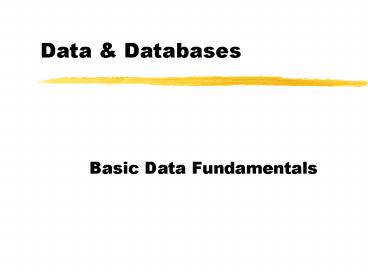Data - PowerPoint PPT Presentation
Title:
Data
Description:
Most current systems store atomic data. ... Parity Bit. 7 Data Bits. 27 = 128 distinct characters. Atomic Data. Because atomic variables are ... – PowerPoint PPT presentation
Number of Views:652
Avg rating:3.0/5.0
Title: Data
1
Data Databases
- Basic Data Fundamentals
2
Data vs Information
- Data facts
- Computer systems store data.
- Information facts organized for a specific
application - Information is the output of a computer system
3
Data
- Atomic Data
- Data in units that cannot be subdivided
- First Name, Price, etc.
- Binary Large Objects (BLOB)
- Images and figures
- Pictures, Cartoons
- Objects
- Data and associated processes
- Spreadsheet tables, graphics components
4
Atomic Data
- Most current systems store atomic data. Atomic
data is typically made up of characters (letters
and numbers) stored in coded groups of 8 bits
called bytes. - ASCII American Standard Code for Information
Interchange - EBCDIC Extended Binary Coded Decimal Interchange
Code
5
Byte
Parity Bit
7 Data Bits
27 128 distinct characters
6
Atomic Data
Because atomic variables are made up of a
relatively small number of codes, computers can
interpret and manipulate them
7
Binary Large Objects
- These are typically bit mapped pictures or images
(such as FAXs) that are stored. Parts of these
pictures have meaning (unlike atomic data).
Digital pictures, video clips, stored images and
signatures are BLOBs. - PIXEL blobs are usually stored as pixel codes
that represent a point on a video screen
8
Bit Maps
1028
1028 x 640 657,920 pixels Black White 1 bit
per pixel 256 tone Color 8 bits per pixel
640
High Resolution
9
Image Processing
Images cannot be processed easily (other than
displayed and scaled) by normal technology
and usually require attached atomic indexes.
Text images can be con- verted although the
software is not fully reliable.
10
Objects
- Objects combine data and the processes that
manipulate it. An example of an object is a
spreadsheet table imported with the manipulation
rules. - Encapsulation
- Formal Interface for Messages
- Inheritance
11
Object Processing
Object databases are new technologies with
immature design methodologies. They promise
extensive code reuse and easy system development
if the tech- nology proves itself.
12
Data, Metadata and Business Rules
- Metadata is data about data, the structure
descriptions of the stored files. Metadata
includes location, format, field name, data
description, etc. - Business rules include editing and processing
rules as well as automatic procedures that must
be processed for accurate data.
13
Data Access Technology
- Flat File structures.
- Data in one location metadata and business
rules in programs - Database Management Systems
- Data and metadata together business rules in
programs - Object Oriented systems
- Data, metadata and business rules together
14
Database Approach
FILE SYSTEM
Program 1
Metadata
Data
Program 2
Metadata
Program 3
Metadata
DATABASE
Program 1
Meta- Data
Data
Program 2
Program 3
15
Distribution Strategies for Databases
Centralized Data and Processing Dumb terminal
with "screen scraping". Intelligent Terminal
Data and processing centralized data
preparation and display on remote
devices. Distributed Logic Data storage
distributed processed at the optimal location.
A version of parallel processing. Client Server
Data (usually departmental) maintained on a
server. Subsetting occurs on the server,
processing on client machines. Distributed
Database Data distributed among different
locations processing access data wherever it is
located. Data may be replicated or partitioned.
16
Central Data with Dumb Terminals
Data
17
Simple Client/Server
18
Multi-Tier Client/Server
Data
Business Rules
Application
19
Distributed Processing
20
Data Trends
- Centralized and Client/Server systems
- Multi Layered architectures
- Objects and encapsulation
- Data driven organizations
- Data warehousing
21
D
A
T
A

